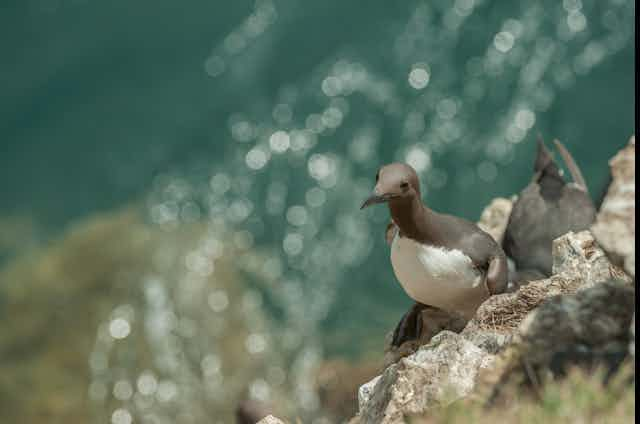Over the past few decades, Skomer Island off the south coast of Wales has witnessed a remarkable resurgence in its guillemot population. Before 1930, Skomer was home to over 100,000 common guillemots. But by the end of the second world war, this number had plummeted by about 95% and continued to decline for the next few decades.
This population decline was probably caused by chronic oil pollution during the second world war and several major oil tanker incidents in the subsequent years. In 1967, for example, the supertanker SS Torrey Canyon spilled over 100,000 tonnes of crude oil into the English channel.
However, counts conducted by the Wildlife Trust of South and West Wales show that Skomer’s guillemot population has consistently grown at an annual rate of about 5% since the 1980s. In 1972, there were around 2,000 guillemots breeding on Skomer. Fast forward to 2023 and that number has skyrocketed to around 30,000.
This resurgence has been the subject of a long-term study conducted by myself and my colleagues over past 50 years. The increase in Skomer’s guillemot population is remarkable considering that populations in northern regions of the country have declined over the same period.
But our study also reveals that seabirds, including Skomer’s guillemots, now face several pressing threats – with climate change emerging as one of the most significant challenges.

Guillemots on the rise
We have been monitoring the survival and breeding success of guillemots on Skomer. Our aim was to establish whether chick production, breeding age and adult and chick survival rates could explain the observed increase in their numbers. It took 30 years until we had a sufficient sample size to address these questions.

Our results showed that the population increase since 1980 is entirely due to the productivity and survival of the Skomer birds themselves. In fact, there’s relatively little immigration or emigration affecting the colony’s numbers.
There has, however, been a marked reduction in oil pollution in waters surrounding the UK in recent years. In the 1970s, around 90% of the dead guillemots found on beaches surrounding the North Sea were contaminated with oil. By 2020, this proportion had fallen to 10%.
This decline in oil pollution may be what has allowed the guillemot population on Skomer and other southern regions of the UK to bounce back towards the levels seen before 1930.
Breeding earlier
However, seabirds, including Skomer’s guillemots, continue to face a multitude of threats. Oil pollution has declined, but it has been superseded by the even more insidious and far-reaching effects of climate change. Together with persistent overfishing and the recent emergence of avian flu, climate change has further contributed to the increasing fragility of seabird populations.
One of our most striking results is that the timing of guillemot breeding has advanced by more than two weeks on average since the 1970s. The cause of this advance, which has also been noted in many bird species on land, is probably climate change.
We believe the early breeding season might be linked to the seasonal availability of their fish prey. There is increasing evidence that warmer seas are having a marked effect on both the distribution and abundance of marine fish in the UK.
Dealing with extreme weather
Climate change is also causing an increase in the frequency and intensity of winter storms. Sustained bad winter weather makes it difficult for guillemots and puffins (another member of the bird family known as auks) to find food. This can lead to devastating “wrecks” where large numbers of dead seabirds wash up on the shore.
In early 2014, a series of storms resulted in the deaths of over 55,000 seabirds around European coastlines, including 15,000 guillemots. In that year, the mortality rate of Skomer’s adult guillemots doubled to 12%.

More worrying is the increasing incidence of extreme weather during the guillemots’ breeding season. Summers are witnessing stronger winds, rougher seas, torrential rain and extreme heat – all of which can reduce guillemot breeding success.
In May 2022, for example, two unseasonal storms resulted in many guillemots losing their eggs from breeding ledges, leading to the lowest breeding success we have seen on Skomer for several decades.
Long-term studies like mine provide the information that allows us to identify and measure the effects of different threats. In a few cases, they may also allow us to take action to minimise their effects. Yet these studies are few and far between.
As I see it, long-term studies on Skomer provide the ammunition that can help us fight the war against climate change and environmental degradation. Now more than ever, it is important that such studies continue.

Don’t have time to read about climate change as much as you’d like?
Get a weekly roundup in your inbox instead. Every Wednesday, The Conversation’s environment editor writes Imagine, a short email that goes a little deeper into just one climate issue. Join the 20,000+ readers who’ve subscribed so far.

